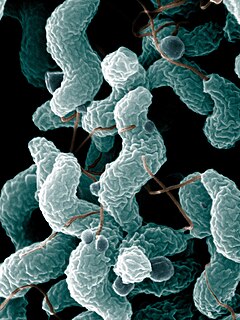Related Research Articles
The Aquificae phylum is a diverse collection of bacteria that live in harsh environmental settings. The name 'Aquificae' was given to this phylum based on an early genus identified within this group, Aquifex, which is able to produce water by oxidizing hydrogen. They have been found in springs, pools, and oceans. They are autotrophs, and are the primary carbon fixers in their environments. These bacteria are Gram-negative, non-spore-forming rods. They are true bacteria as opposed to the other inhabitants of extreme environments, the Archaea.

Acidobacteria is a phylum of bacteria. Its members are physiologically diverse and ubiquitous, especially in soils, but are under-represented in culture.

Epsilonproteobacteria are a class of Proteobacteria. All species of this class are, like all Proteobacteria, Gram-negative.
The Gemmatimonadetes are a phylum of bacteria established in 2003. The phylum contains two classes Gemmatimonadetes and Longimicrobia.
Mycobacterium bolletii is a bacterial species of the phylum Actinobacteria and the genus Mycobacterium. It was named in honor of Claude Bollet, a famous clinical microbiologist and taxonomist.
Mycobacterium houstonense is a member of the Mycobacterium fortuitum third biovariant complex. The specific epithet houstonense refers to Houston, Texas, where the first isolate of the M. fortuitum third biovariant (sorbitol-positive) was identified.
Mycobacterium neworleansense is a member of the Mycobacterium fortuitum third biovariant complex.
Cronobacter is a genus of Gram-negative, facultatively anaerobic, oxidase-negative, catalase-positive, rod-shaped bacteria of the family Enterobacteriaceae. They are generally motile, reduce nitrate, use citrate, hydrolyze esculin and arginine, and are positive for L-ornithine decarboxylation. Acid is produced from D-glucose, D-sucrose, D-raffinose, D-melibiose, D-cellobiose, D-mannitol, D-mannose, L-rhamnose, L-arabinose, D-trehalose, galacturonate and D-maltose. Cronobacter spp. are also generally positive for acetoin production and negative for the methyl red test, indicating 2,3-butanediol rather than mixed acid fermentation. The type species of the genus Cronobacter is Cronobacter sakazakii comb. nov.
The Chloroflexi or Chlorobacteria are a phylum of bacteria containing isolates with a diversity of phenotypes, including members that are aerobic thermophiles, which use oxygen and grow well in high temperatures; anoxygenic phototrophs, which use light for photosynthesis ; and anaerobic halorespirers, which uses halogenated organics as electron acceptors.
Aquamicrobium aerolatum is a gram-negative, oxidase-positive, aerobic, rod-shaped, motile bacteria from the genus of Aquamicrobium which was isolated from air from a duck shed in Germany. Defluvibacter lusatiensis was transferred to Aquamicrobium aerolatum.
Aquamicrobium aestuarii is a gram-negative, catalase- and oxidase-positive strictly aerobic, motile bacteria with a flagellum from the genus of Aquamicrobium which was isolated from the Yellow Sea in South Korea.
Aquamicrobium ahrensii is a gram-negative, aerobic, bacteria from the genus of Aquamicrobium which was isolated from biofilter from an animal rendering plant in Germany.
Aquamicrobium defluvii is a gram-negative, oxidase- and catalase-positive, bacteria from the genus of Aquamicrobium which was isolated from activated sewage sludge in Germany. Aquamicrobium defluvii uses thiophene-2-carboxylate as only source for carbon.
Aquamicrobium lusatiense is a Gram-negative, oxidase-positive, strictly aerobic bacteria from the genus Aquamicrobium with a polar flagellum, which was isolated from activated sludge in Germany. Aquamicrobium lusatiense is able to degrade 2,4-dichlorophenol, 4-chloro-2-methylphenol, 4-chlorophenol, and phenol. Defluvibacter lusatiensis was transferred to Aquamicrobium lusatiense
Aquamicrobium segne is a Gram-negative, aerobic bacteria from the genus Aquamicrobium which was isolated from a biofilter of an animal rendering plant in Germany.
The Natranaerobiales are an order of bacteria placed within the class Clostridia. This order contains the thermophilic bacterial species Natranaerobius thermophilus and the related species Natranaerobaculum magadiense.
The Orbales are an order of Proteobacteria with the single family Orbaceae. This order was created to accommodate novel bacterial species isolated from the guts of honeybees and bumblebees.
Nocardioides is a Gram-positive, mesophilic and aerobic bacterial genus from the family of Nocardioidaceae.
Aquamicrobium terrae is a Gram-negative, aerobic and non-motile bacteria from the genus of Aquamicrobium which has been isolated from soil which was contaminated with aromatic compounds in Nanjing in China.
Aquamicrobium soli is a Gram-negative, aerobic, short rod-shaped non-spore-forming and non-motile bacteria from the genus of Aquamicrobium which has been isolated from soil which was contaminated with chlorobenzoate in China.
References
- 1 2 3 Parte, A.C. "Aquamicrobium". LPSN .
- ↑ Lipski, A.; Kampfer, P. (2011). "Aquamicrobium ahrensii sp. nov. And Aquamicrobium segne sp. nov., isolated from experimental biofilters". International Journal of Systematic and Evolutionary Microbiology. 62 (Pt 10): 2511–6. doi:10.1099/ijs.0.038224-0. PMID 22155762.
- ↑ UniProt